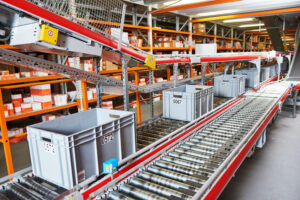Overhauling Last Mile Fulfillment with Automation and Robotics

Last-mile fulfillment is one of the most challenging logistical pieces in the entire supply chain puzzle.
Over the last several years, the pressure for manufacturing companies to ease and shorten their delivery times has been an insurmountable hiccup that left organizations exploring different strategies and tactics to implement in their models. But the greatest challenge was seen during 2020 at the height of the pandemic where customer demand played an integral role in disrupting last-mile deliveries. As customers collectively abandon in-person purchasing for online shopping, supply chain companies quickly scour for solutions to equally satisfy clients and ensure that business operations are seamless.
In a recent forecast, the global last-mile delivery market is projected to increase by $165.6 billion between 2023 and 2027, accelerating at a compound annual growth rate of 15.62%. This dramatic increase is attributed to the growing customer expectations post-pandemic.
During the lockdown, customers only cared about making ends meet. It was a different time, and as long as goods were delivered and services continued, customer satisfaction was met. But as the global industry slowly shifted to the post-pandemic world, a new standard was introduced that completely reshaped customer expectations. From premium goods, and seamless customer experience, to faster delivery times, this rapid change continues to shatter old practices and outdated models.
One of the primary contributors to the pressure of e-commerce revolutionizing their ways to meet customer demand post-pandemic is the return of in-person shopping. According to CNN, 72% of customers are expected to return to brick-and-mortar outlets, posing a significant threat to e-commerce brands. However, approximately 335.25 million customers in the US alone are expected to continue shopping online. To seize this opportunity, quick commerce and direct-to-consumer retail brands are fast to think on their feet to invest in the most advanced technologies to achieve customer retention amidst the threat of an in-store renaissance.
Two of the key technological capabilities that global leaders are investing in is automation and robotics to ease the challenges of last-mile fulfillment. From boosting efficiency, reducing manual effort, eliminating risks of human error, to reducing costs, the abundance of benefits these solutions provide both retailers and consumers is worth noting.
Solving Logistics Nightmare with Dark Stores
Automation is designed to improve warehousing performances and streamline supply chain processes. 1MRobotics, an Israel-based startup that develops robotic nano-fulfillment centers and creates next-gen dark stores, aims to overhaul traditional supply chain logistics through the provision of dark stores in communities.
According to a study conducted by Vaimo, the dark store industry is expected to help retailers skyrocket their profit to nearly $6.5 trillion by the end of 2023, efficiently competing against the return of physical store shopping. Since the entire micro-fulfillment process is automated, dark stores optimize order accuracy, inventory management, and delivery speed.
1MRobotics has introduced two cutting-edge solutions designed to fulfill the unique needs of quick commerce and on-demand rapid delivery: Genesis and Flexsis. Genesis caters the needs of retail and CPG DTC fulfillment. It’s designed and engineered to seamlessly integrate into existing logistical infrastructures while enabling rapid delivery. On the other hand, Flexsis is made to maintain all the operational advantages of Genesis, which include immediate deployment, full automation, bulk loading, and diversified inventory.
The path toward supply chain optimization starts with forward-thinking leaders who recognize industry deficiencies and invest in state-of-the-art technologies to boost business efficiency. With key players like 1MRobotics, the supply chain arena displays a promising future that equally satisfies retail brands and end customers amidst continuous disruptions.




